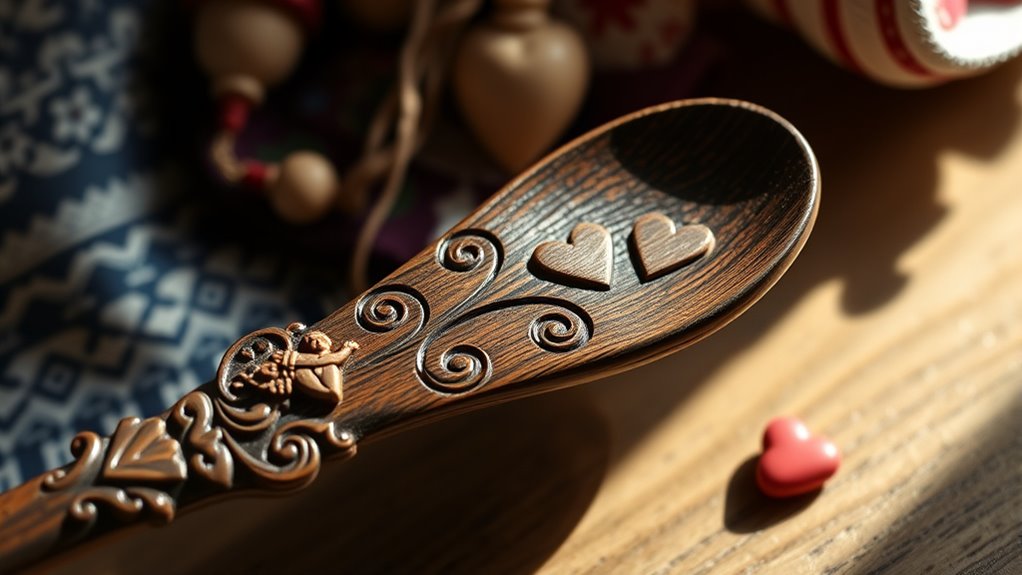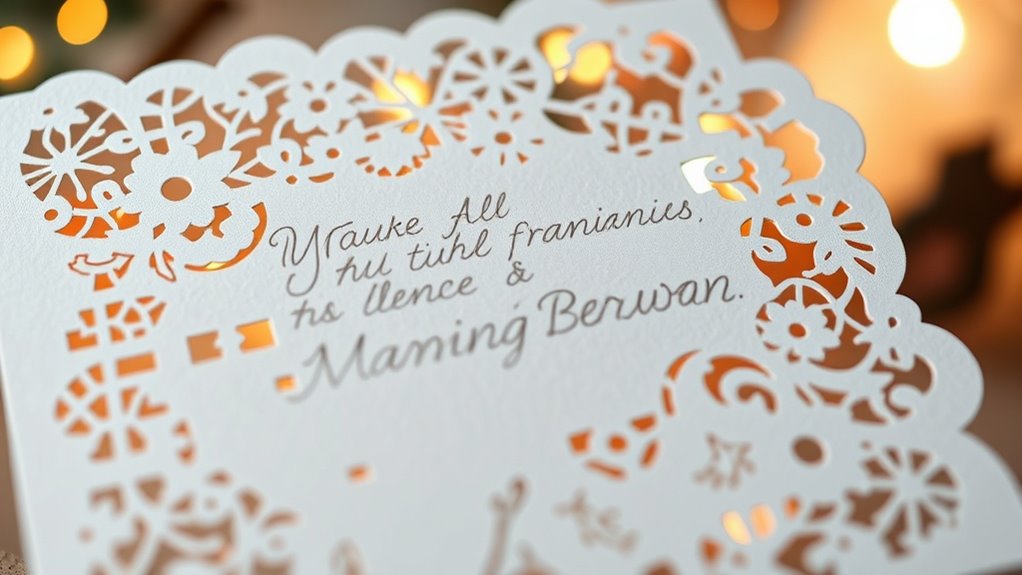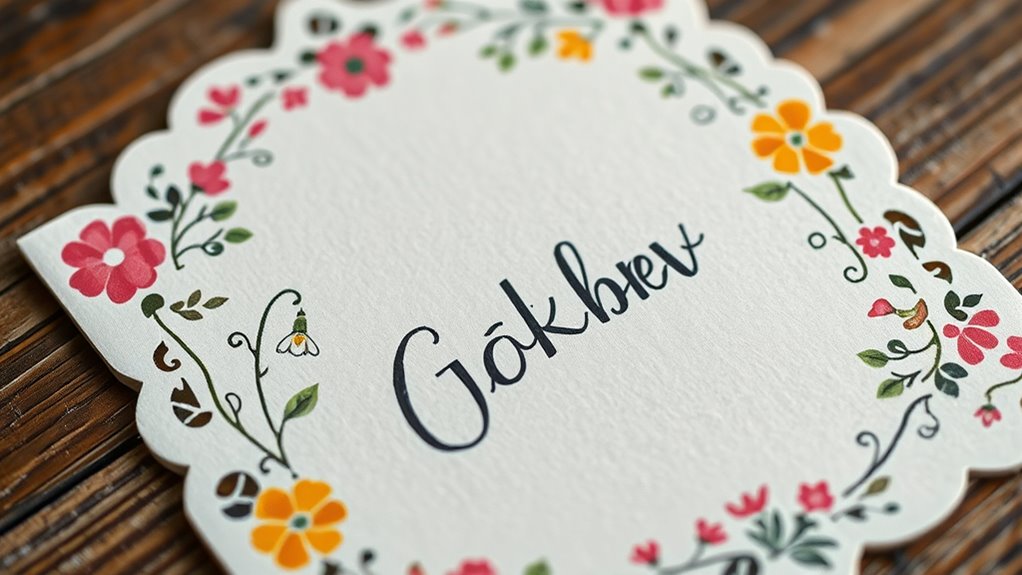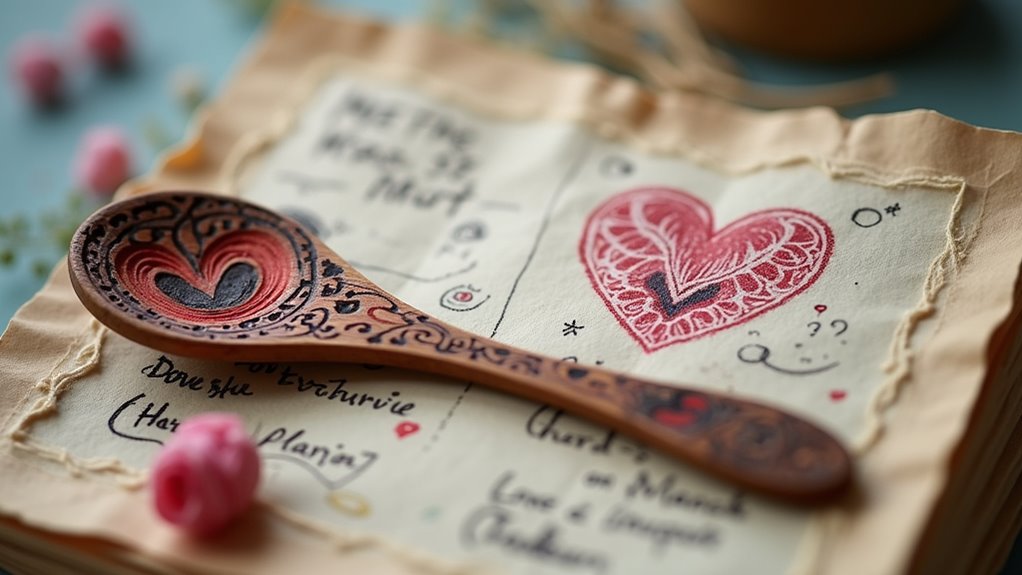Some believe that quirky customs like Wales’ love spoons and Denmark’s gækkebrev reveal little more than playful traditions, but they actually hold deeper cultural meanings. These practices symbolize affection, community, and craftsmanship, yet their origins and evolving significance remain intriguing. As you explore these traditions further, you’ll discover how they reflect societal values and personal connections that have endured through time—if you’re willing to uncover what makes them truly special.
Key Takeaways
- Wales’ love spoons and Denmark’s gækkebrev both originate from medieval traditions expressing affection, with distinct regional symbols and craftsmanship.
- Love spoons are carved tokens featuring motifs like hearts and knots, symbolizing love and commitment, crafted by young men historically.
- Gækkebrev are poetic, cryptic notes with artistic drawings, serving as playful anonymous love or friendship messages during Easter.
- Both customs have evolved, blending traditional symbolism with modern creativity to maintain cultural relevance and personal significance.
- These quirky traditions reflect societal values like love, humor, craftsmanship, and community, fostering cultural identity and continuity.
The Origins of Wales’ Love Spoons

Wales’ tradition of giving love spoons dates back centuries, rooted in a desire to express affection and good wishes. These spoons symbolize love and hope, serving as heartfelt tokens between loved ones. As part of folk art traditions, they often feature intricate carvings and meaningful motifs, each with specific symbolism in love. For example, a heart might represent affection, while a knot signifies enduring commitment. Historically, young men crafted these spoons for their sweethearts, using simple tools to create detailed designs. Over time, love spoons evolved into a cherished cultural practice, combining artistic craftsmanship with personal sentiment. The drivetrain components and the tools used to carve these spoons reflect a similar craftsmanship and attention to detail. They embody Welsh heritage, blending symbolic meaning with folk art traditions to celebrate love in a uniquely expressive way.
Crafting and Giving: The Tradition of Love Spoons

The craftsmanship behind love spoons transforms simple materials into meaningful tokens of affection. You’ll notice the symbolic motifs carved into each spoon, representing qualities like love, luck, or protection. These motifs are rooted in folk artistry, reflecting local traditions and beliefs. When you craft a love spoon, you’re not just making a decorative object—you’re creating a personal message. Giving it to someone special signals your affection and intentions. The act of carving and presenting a love spoon carries cultural significance, making it a cherished gesture across generations. Whether the motifs are intricate or straightforward, each spoon embodies a heartfelt sentiment. Additionally, understanding the symbolic significance of each motif enhances the emotional value of the gift. This tradition connects artisans and recipients through a shared appreciation of folk artistry and meaningful symbolism.
The Enigma of Denmark’s Gækkebrev

Have you ever wondered about the origins of Denmark’s Gækkebrev? These mysterious, poetic snowdrops carry hidden clues that reveal the sender’s identity. Let’s uncover the tradition and the secret messages woven into this unique custom. Engaging in mindful decluttering strategies can help preserve these cultural treasures by organizing and maintaining relevant memorabilia.
Origin and Tradition
Although the origins of Denmark’s gækkebrev remain somewhat mysterious, these intricate paper poems have long been a cherished tradition rooted in centuries of folklore. They serve as symbolic gestures of affection during Easter, blending humor and mystery. You might find that gækkebrev:
- Dates back to medieval times, linked to spring rituals
- Originated as a way to anonymously express love or friendship
- Has been preserved through generations as part of Danish cultural heritage
- Features creative, hand-crafted designs that reflect local artistry
- Often incorporate traditional motifs and craftsmanship techniques that highlight regional styles
This tradition exemplifies cultural preservation, keeping alive a playful way to connect with loved ones. The gækkebrev’s history highlights how folklore and customs evolve, yet remain meaningful symbols of community and affection. By understanding its origins, you see how this quirky custom continues to symbolize warmth and tradition.
Hidden Poetic Clues
Hidden poetic clues lie at the heart of each gækkebrev, turning these simple paper poems into playful puzzles. You’ll notice that the sender uses poetic riddles to hide their identity, adding an element of mystery. These clues often involve symbolic gestures, such as clever wordplay or subtle references, making decoding part of the fun. The recipient must interpret the poetic riddles to uncover who sent the note, transforming a straightforward gesture into a delightful challenge. Every gækkebrev acts as a miniature cipher, where each line and rhyme carries hidden meaning. This blend of poetic language and symbolic gestures elevates a simple tradition into a clever game of wit, fostering connection through creativity and mystery. Additionally, understanding the weight of wind turbine blades and their design can inspire similar innovative thinking in crafting complex riddles and puzzles.

You’ll notice that Gækkebrev often contain cryptic poems and puzzles that reveal hidden messages. These riddles are complemented by hand-drawn artistic elements that add charm and personality. Together, they transform a simple note into a creative expression of affection. Paying attention to sprayer components and their proper maintenance can be likened to deciphering these intricate notes, as both require careful inspection and understanding to ensure optimal performance.
Cryptic Poems and Puzzles
Gækkebrev are renowned for their clever use of cryptic poems and puzzles that challenge recipients to decipher hidden messages. These riddles often conceal affectionate words, requiring you to analyze wordplay and clues carefully. The poems showcase folk artistry, blending poetic flair with symbolic gestures of love and friendship. You might encounter:
- Rhyming couplets with concealed initials
- Word puzzles that require decoding to reveal names
- Hidden acrostics spelling out secret messages
- Clever riddles that ask for specific interpretations
These cryptic elements turn the exchange into a playful challenge, emphasizing creativity and wit. The artistry behind these puzzles reflects cultural traditions, making each Gækkebrev a unique piece of folk craftsmanship. Their cryptic poems deepen emotional connections through symbolic gestures woven into poetic puzzles. Moreover, such traditions highlight the importance of cultural heritage and the enduring value of folk artistry in fostering community bonds.
Hand-Drawn Artistic Elements
Hand-drawn artistic elements elevate Gækkebrev by infusing each card with personal charm and creativity. You’ll notice expressive symbolic motifs, like flowers or hearts, that convey emotion beyond words. Artistic techniques such as delicate line work, shading, and vibrant coloring add depth and flair. These handcrafted details transform simple messages into visual stories, revealing the sender’s affection and effort. The unique style of each Gækkebrev reflects individual artistry, making every card a one-of-a-kind keepsake. To better understand, consider this table:
| Symbolic Motifs | Artistic Techniques | Personal Touch |
|---|---|---|
| Hearts & Flowers | Line Drawing & Shading | Handwritten Messages |
| Birds & Stars | Colorful Accents | Unique Personal Symbols |
| Nature Elements | Textured Details | Custom Doodles |
| Abstract Shapes | Fine Line Art | Signature Style |
These artistic elements turn Gækkebrev into expressive, heartfelt pieces of art. Additionally, the visual appeal of these cards often enhances the emotional impact of the message.
Cultural Significance and Modern Celebrations

Cultural significance often gives tradition its deeper meaning, transforming simple customs into cherished symbols of identity. Modern celebrations keep these rituals alive through evolving traditions and symbolic gestures that connect generations. You might notice how these customs adapt while maintaining their core importance. For example:
- Celebrants incorporate contemporary elements, blending old and new.
- Traditional symbols are used in creative ways to reflect current values.
- Community events emphasize participation and shared heritage.
- Personal touches, like handmade decorations, honor historical roots.
- Innovative indoor gardening solutions, such as unique planters, demonstrate how traditions can inspire modern creativity.
These evolving traditions help you appreciate the cultural depth behind quirky customs. They foster a sense of belonging and continuity, ensuring that meaningful symbols remain relevant. In this way, customs remain vibrant, embodying both history and the present, resonating with people across generations.
What These Customs Reveal About Their Societies

By examining how these customs are practiced today, you can uncover a lot about the values, social structures, and priorities of the societies that keep them alive. Cultural symbolism embedded in traditions like love spoons or Gaekkebrev reveals what each society holds dear—whether it’s love, humor, or community bonding. These customs often reflect societal values such as generosity, creativity, or personal connection. They serve as tangible expressions of identity, emphasizing traits that are celebrated or cherished within the culture. For example, intricate love spoons highlight craftsmanship and affection, while playful Gaekkebrev reveal a society that values wit and humor. Additionally, the integration of AI in media and entertainment is transforming how cultural stories are created and shared today. Overall, these customs act as windows into what each society considers important and how it maintains its unique cultural identity.
Frequently Asked Questions
How Did These Customs Originate Historically?
You might wonder how these customs started. Their cultural origins trace back centuries, often rooted in local traditions and social practices. Over time, they’ve evolved through historical changes, adapting to new influences while maintaining core meanings. These customs reflect community values, love, humor, or societal norms, and their historical evolution shows how traditions transform yet stay connected to their roots. Understanding this helps you appreciate their unique cultural significance today.
Are Love Spoons and Gækkebrev Still Popular Today?
You might wonder if love spoons and gækkebrev still hold popularity today. These customs maintain their cultural significance, symbolizing affection and creativity in modern times. While traditional forms remain cherished, many people adapt them with contemporary designs or personalized touches, blending old traditions with modern aesthetics. This ongoing relevance shows how these quirky customs continue to connect people emotionally, celebrating love and humor in today’s world.
What Materials Are Traditionally Used for Making Love Spoons?
When you’re crafting love spoons, you use traditional materials like wood, bone, or ivory, each carrying its own symbolism. The crafting techniques involve carving, shaping, and decorating to express affection. These materials symbolize strength, purity, or eternity, making your love spoon a meaningful token. By choosing these materials carefully, you honor the tradition while creating a unique, heartfelt gift that captures your emotions through timeless craftsmanship.
How Do These Customs Compare to Other Global Romantic Traditions?
You see, these customs highlight cultural significance and offer a glimpse into regional values. Compared to other global romantic traditions, like Japan’s love seals or France’s poetic cards, they often emphasize personal touch and symbolism. Modern adaptations, like digital love notes or custom jewelry, keep the essence alive while blending tradition with contemporary trends. You can appreciate how each culture uniquely celebrates love through meaningful, sometimes quirky, customs.
Are There Specific Regional Variations Within Each Country?
Thinking about regional variations is like exploring a treasure map—you find surprises at every turn. Within each country, regional dialects influence how customs like love spoons or Gækebrev are made and shared. Local artisans often adapt traditions to reflect their community’s unique flavor, making each version special. So, yes, you’ll notice distinct local twists that add depth and charm to these quirky customs, showing how regional culture shapes romantic gestures.
Conclusion
As you imagine the delicate carvings of Welsh love spoons or the playful riddles of gækkebrev dancing in spring breezes, you see how these customs weave love and humor into daily life. They’re like tiny keepsakes, carrying stories and promises across generations. These traditions remind you that, beneath simple acts, there’s a rich tapestry of culture and connection—beautiful symbols that keep their communities close, no matter how time changes their surroundings.









